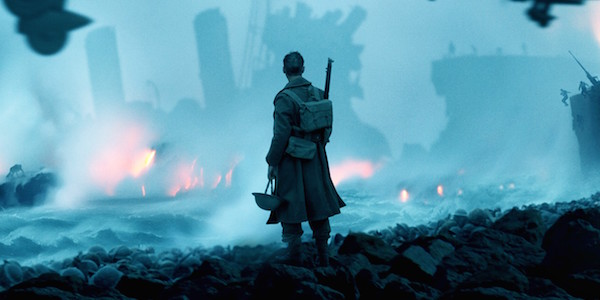Visions of “Dunkirk”


By Chad Goss
Grade for “Dunkirk”: B-
If I were to give Dunkirk just a film grade, it would be a solid A. The performances, non-linear storytelling, score, storyline, and some of the shots all combined to create the best and most enjoyable viewing experience so far experienced in this class. The combination of three different narrative threads, on land, on sea, and in the air, all following one or several major characters as they attempt to leave or get to Dunkirk was a viewing experience that demands repeat viewings as a film. However, my job is to grade the film as a historical film, and in that sense this film earns a B-.
The strengths of Dunkirk come from the filmmaking. It is without a doubt one of the most visually stunning films I have ever seen and for sure this is the most well shot and edited film seen in our class with certain shots of the sea and the beaches being breathtaking. The nonlinear storytelling and lack of much dialogue throws viewers into the confusion and uncertainty that many of the characters in the film would have been feeling at the time as well. Finally, the score completes the viewing experience by drawing viewers fully into the film. Each moment of music or sound clues the viewer in on what is coming next and at certain points the lack of any extra music leaves the viewer feeling as if they two were experiencing the events first hand. All around an impressively made film that deserves much praise for maintaining the emotional truths of the soldiers by showing their despair, hopelessness, and overall uncertainty throughout the entire film. Even though the viewers knows many of them will be saved, the viewer is still left with a sense of dread and worry much like the characters in the scene.
What truly brings this film down in its rating is its inability to draw on the historical truths about the presence and sacrifices of imperial soldiers at this moment in history. Robert Rosenstone makes a point of emphasis that maintaining accuracy is a primary component to creating a good historical film. It is the responsibility of these films to represent and portray history as closely as possible to the way that it actually happened. Dunkirk does a great job with physical aspects such as uniforms, vehicles, and timelines, but it fails to include all those who were there. By ignoring those who sacrificed their lives the film creates historical inaccuracy and throughout the semester this has proven to be an error that must result in a lower grade. Dunkirk is not exempt from this just because it is a high quality film.
It is a shame that more care was not taken in ensuring the historical accuracy of the film was complete and peoples were included in the final cut of the film. If this had been done, Dunkirk might have stood above the rest as film depicting history while also creating an incredibly pleasing viewing experience. However, despite all of the greatness that was achieved in the filmmaking process, it is undone by the choice to not accurately represent all of those where truly there and sacrificed all everything.
Chad Goss is a senior majoring in Finance with a minor in History.